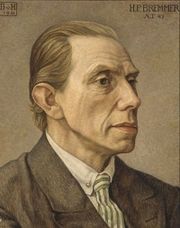Henk Bremmer's Human Design Chart
3/5 Emotional GeneratorDutch painter, art critic, educator and collector.
Bremmer was called the “kunstpaus” (art pope) of the Netherlands. He was one of the fist influential persons to recognise the value of Vincent van Gogh. He arranged long lasting stipends for Bart van der Leck (1912-45)and others in the hope that he could make a more secure living of his art.
Bremmer advised his student Helene Kröller-Müller, (11 February 1869, Essen – 14 December 1939, Otterlo), then the richest woman of the Netherlands, in establishing her art famous collection. Helene donated in 1935 her collection to the Dutch state, on condition that a large museum be built in the gardens of her park in Otterlo. The Kröller-Müller Museum was opened in 1938.
In 1951 Bremmer received a honorary Doctorate in Groningen.
He died 10 January 1956 in Den Haag.
Personal.
On 2 October 1895 he married Aleida Magdeltje Beekhuis (20 April 1866, Buitenpost – 26 July 1945, Den Haag). They got three sons and a daughter. His son Rudolf Bremmer (16 April 1900, Den Haag – 26 October 1993, Laren) became a painter and Henk Bremmer (23 March 1904 – 6 February 1996) a physicist.
Link to Wikipedia
Discover More Famous People
Browse and analyze over 55,000 public figures and celebrities.
Ra Uru Hu
5/1 Manifestor
Martha Stewart
4/6 Manifestor
David Lynch
4/6 Generator
Barack Obama
6/2 Projector
Steve Jobs
6/3 Generator
Vladimir Putin
5/1 Manifestor
Kim Kardashian
3/5 Generator
Michael Jackson
1/3 Projector
Marilyn Monroe
6/2 Projector
Ariana Grande
2/4 Projector
Oprah Winfrey
2/4 Generator
Johnny Depp
2/4 ManifestorWhat is HumanDesign.ai and how does it work?
Curious what makes Henk Bremmer tick? HumanDesign.ai instantly maps their exact birth data into a fully interactive clickable bodygraph chart, letting you hover or tap every center, channel, and gate for plain-language explanations. Bella, the platform’s built-in AI guide, adds context in real time, translating complex mechanics into everyday insights so you can see how Henk Bremmer’s strengths, challenges, and life themes play out on-screen.
The same tools are waiting for you. Generate your own Human Design Chart in seconds, open a library of 2000+ suggested questions, and chat with Bella as often as you like to decode your design, daily transits, and even relationship dynamics.
Want to compare energies? Save unlimited charts for friends, family, or clients, then ask Bella to reveal compatibilities, composite patterns, or coaching tips, all in one conversation thread.
Start free with core features, or unlock our Personal and Pro plans for deeper dives: unlimited Q&A, celebrity chart search spanning 55,000+ public figures, white-label PDF reports, branded content generation, and a professional profile with built-in booking for practitioners. Whether you’re exploring your own potential or guiding others, HumanDesign.ai delivers an ever-expanding toolbox of AI-powered insights—no spreadsheets, no jargon, just clarity at your fingertips.
Ready to see yours? Signup for FREE today!

